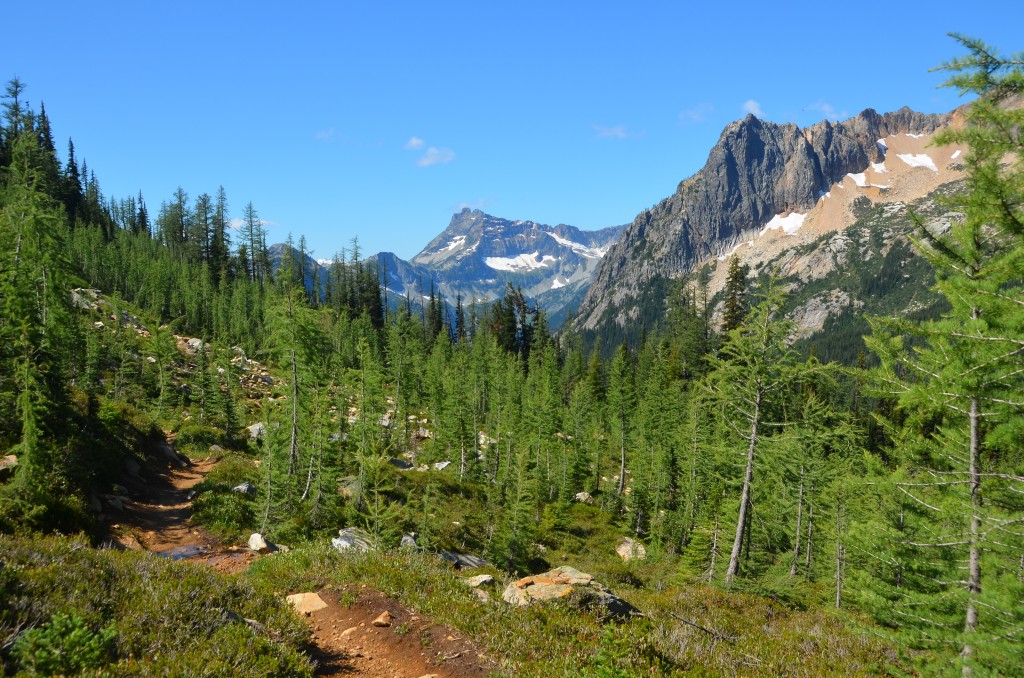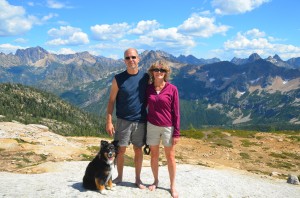Backpacking in Washington’s North Cascades
by Curt Remington
The short section we backpacked, on the Pacific Crest Trail, climbs up to Cutthroat Pass and follows alpine ridges through some spectacular mountain scenery. My wife Mary, Riva our dog, and I started at Washington’s Rainy Pass trailhead and headed north, on the last section of trail before the Canadian border.
We climbed gradually through fir and cedar forest and reached our camp at Porcupine Creek, at the head of a valley, by late afternoon. Mosquito Creek might be a better name for that insect infested campsite. Mosquitoes swarmed around our heads and gave us a strong incentive to set up camp quickly, so we could escape from the bugs.
Before we’d cooked our dinner, the sky clouded over and thunder rumbled nearby. Next hail pelted our heads and buried itself in Riva’s coat. Our experience has been that western Washington hail usually passes quickly, so we stood under a tree, waiting for it to pass. Not this time! The hail kept up and was soon accompanied by lightning along with an absolute deluge of rain. We hadn’t bothered to put rain pants on or crawl into the tent. All three of us were almost instantly soaked.
Later I learned from the National Park Service website that “a large and powerful storm cell triggered a massive mud and rock slide” that night. The slide was 10 miles to the south, but we sure felt the effects of the storm. After a cold, quick dinner, we three very wet campers huddled in our very wet tent and listened to rain and hail drum on the tent while lightning flashed and thunder echoed in the valley. Riva, our Australian shepherd, looked especially pitiful with her fur soaked, wearing Mary’s fleece vest, and squeezed between us for warmth.
During the night, both Riva and I slid downhill, off my Thermarest and onto my wet pile of clothes along the edge of the tent. As you might’ve guessed, I didn’t get a whole lot of sleep that night. But, sometime during the night, the storm moved on, and the rain stopped. The next morning I discovered that Riva had dried and looked reasonably comfortable. Mary slept soundly, so I quietly crawled out and started hanging wet gear in the surrounding trees.
We decided to leave our tent and sleeping gear at Porcupine Creek and hike light for the day. By the time we were organized, the sun actually came out. In half a mile or so, we found beautiful campsites with views down the valley. Enough of a breeze blew up the valley to minimize insects. These campsites are very close to the ridge though and would have been much more dangerous in the prior night’s thunderstorm.
Not far beyond the camps, we reached Cutthroat Pass, with panoramic views of the surrounding peaks and Cutthroat Lake, far below. Warm sunshine provided quite a contrast with our camping experience the night before. Heading north, we continued on the Pacific Crest Trail, hiking above the tree line, with a new view of the North Cascades mountains around each corner. The trail traverses steep mountains, so parts of the trail had sustained significant damage in the prior night’s storm.
We covered less than ten miles round-trip, returning to camp with plenty of time to gather firewood and have a leisurely dinner. The fire did a wonderful job of keeping mosquitoes at bay, and the weather stayed clear. Riva climbed into the tent early, apparently exhausted. Mary and I sat outdoors and talked until dark, reminiscing about some of our many camping experiences over the years.
Breaking camp early the next day, got us to the car with enough time left over to add in a short hike to Rainy Lake, on the way home. The North Cascades hold countless beautiful hikes. Each year we visit some of our favorites and try to add one or two new ones. This section of the Pacific Crest Trail is a hike we’ll undoubtedly come back to, and maybe someday, we’ll take on a much longer section of that 2650 mile trail.




